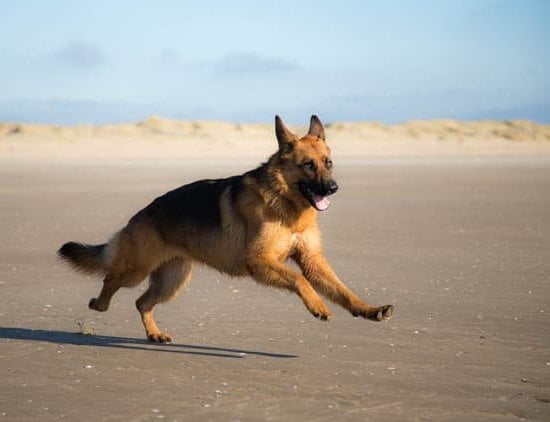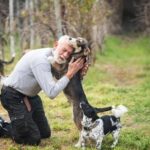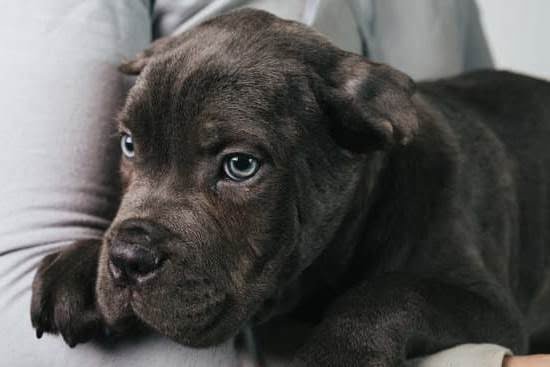Are you wondering, “how to train my dog to not jump on people“? It can be frustrating and even embarrassing when your furry friend greets guests with a leap. In this article, we will explore the reasons behind this behavior and provide effective strategies for training your dog to keep all four paws on the ground.
Understanding why dogs jump on people is the first step in addressing this behavior. Dogs may jump as a way of showing excitement, seeking attention, or even as a form of greeting. By understanding the root causes of jumping behavior, you can better address it through training and positive reinforcement techniques.
Creating boundaries and establishing rules for jumping behavior is essential in curbing this habit. Positive reinforcement using treats and praise can encourage your dog to exhibit desired behaviors while redirecting their attention towards an alternative behavior can also help in teaching them appropriate greetings. Consistency in training routines and exposure to various social situations will also play a critical role in preventing jumping behavior.
Stay tuned as we delve into these topics and more, providing you with practical strategies to train your dog not to jump on people.
Creating Boundaries
Setting Clear Expectations
When it comes to training your dog to not jump on people, setting clear boundaries is essential. Dogs thrive in an environment where rules and expectations are clearly communicated and consistently enforced. It’s important to decide what behavior is acceptable and what is not, and then stick to these guidelines.
Consistent Correction
Consistency is key when it comes to establishing boundaries for jumping behavior. This means correcting the behavior every time it occurs, without exception. If you let your dog jump on you or others sometimes but not others, it will only create confusion for your pet. Consistently enforcing the rule that jumping is not allowed will help your dog understand what is expected of them.
Enlist the Help of Others
It’s also important to communicate these rules to anyone who interacts with your dog regularly. This includes family members, friends, and visitors. Consistency in enforcing the no-jumping rule from everyone will reinforce the message for your pet, making it easier for them to understand what behavior is acceptable.
By establishing clear boundaries and consistently enforcing them, you can effectively train your dog to not jump on people. This sets a foundation for successful training and ensures that everyone in your household can enjoy a well-behaved canine companion.
Positive Reinforcement
Understanding the behavior of why dogs jump on people is crucial in addressing and training this undesirable habit. Dogs may jump on people as a way to greet them, seek attention, or even out of excitement. It is important to recognize that jumping is a natural behavior for dogs, but it can be modified through training.
Creating boundaries and rules for jumping behavior is essential in teaching your dog not to jump on people. This can include encouraging calm greetings, particularly when guests enter your home or when you’re out for a walk. By establishing clear boundaries, you are helping your dog understand what is expected of them.
Using positive reinforcement methods such as treats and praise can be highly effective in discouraging jumping behavior. When your dog greets someone without jumping, promptly reward them with treats and verbal praise. This positive association will encourage them to repeat the desired behavior.
- Use high-value treats such as small pieces of cheese or cooked chicken.
- Verbal praise should be enthusiastic and immediate after the desired behavior.
- Consistency is key – always reward your dog for not jumping on people to reinforce the desired behavior.
By consistently using positive reinforcement techniques, you can effectively train your dog not to jump on people, ultimately improving their social manners and interactions with others.
Redirecting Attention
When training your dog to not jump on people, it’s important to teach them an alternative behavior to replace jumping. This can help redirect their attention and provide a positive outlet for their energy. One effective alternative behavior is teaching your dog to sit when greeting people. This not only prevents jumping but also encourages politeness and calmness when meeting others.
To train your dog to sit instead of jump, start by practicing the “sit” command in a low-distraction environment, such as your home. Use treats and praise to reinforce the desired behavior, and gradually introduce more distractions as your dog becomes proficient at sitting on command. Once they reliably respond to the “sit” cue at home, practice the command in different locations with varying levels of activity and people around.
Consistency is key when redirecting your dog’s attention from jumping to sitting. Make sure that everyone who interacts with your dog uses the same approach, so they don’t get confused about what is expected of them. It’s also important to continue practicing this alternative behavior regularly, even after your dog has mastered it. This will help solidify the new habit and ensure that they continue to choose sitting over jumping in any situation.
Using positive reinforcement methods such as treats, praise, and toys can be highly effective in teaching your dog an alternative behavior to jumping. Positive reinforcement helps create a strong association between the desired action (sitting) and a pleasant outcome (treats or praise), making it more likely that your dog will choose to sit instead of jump when greeting people.
| Training Method | Effectiveness |
|---|---|
| Teaching “Sit” Command | Highly Effective |
| Consistent Practice | Key for Success |
| Positive Reinforcement | Highly Effective |
Consistency Is Key
Regular Training Sessions
One of the most important aspects of training your dog to not jump on people is establishing a consistent training routine. This means setting aside regular, daily training sessions to work on this specific behavior. By consistently reinforcing the desired behavior and providing clear expectations, your dog will be able to understand what is expected of them.
Clear Communication
Consistency also involves clear communication with your dog. Use the same commands and cues each time you are working on discouraging jumping behavior. This helps your dog understand what is expected of them and reinforces the consistency of your training efforts.
Enlist Family Members and Visitors
Consistency in training requires that everyone in the household is on the same page when it comes to addressing jumping behavior. Enlist the help of family members and regular visitors to ensure that everyone is following the same rules and expectations when interacting with your dog. This will prevent confusion for your pet and help reinforce consistent training efforts across all interactions.
By establishing a consistent training routine, you can effectively teach your dog to not jump on people. Consistency reinforces clear communication, helps set expectations, and creates an environment where everyone involved in interacting with your pet is reinforcing consistent behaviors.
Socialization Strategies
Training your dog to not jump on people involves more than just teaching them the “no jumping” command. It also requires exposing them to different people and situations to help them understand when it is appropriate behavior to greet others. Here are some socialization strategies to help prevent your dog from jumping on people:
– **Introduce Your Dog to Various Individuals:** Take your dog for walks in areas where they can come into contact with different people, such as parks, busy streets, or pet-friendly stores. Encourage polite interactions with strangers by having them offer a treat or a gentle pat on the head when meeting your dog.
– **Arrange Playdates with Other Dogs:** Interacting with other dogs can also help your pet learn appropriate social behaviors. This can teach them boundaries and reduce their excitement when encountering new people.
– **Expose Them to Different Environments:** Bring your dog to various environments so they become accustomed to different sights, sounds, and smells. This exposure can help reduce overexcitement that may lead to jumping on unfamiliar individuals.
By engaging in these socialization strategies, you are helping your dog develop good manners around others while reducing the chances of them jumping on people out of excitement or anxiety. With time and consistent practice, you’ll see an improvement in their behavior when greeting both familiar faces and strangers.
Training Tools and Techniques
When training your dog to not jump on people, using the right tools can be incredibly helpful. One of the most common and effective tools for preventing jumping is a leash or harness.
These can provide you with physical control over your dog when they are tempted to jump, especially in situations where they may become overly excited. Additionally, using a training aid such as a head halter or front-clip harness can also help in redirecting your dog’s attention away from jumping.
Another useful tool is a clicker, which provides an audible signal that can be used to mark the exact moment your dog performs the desired behavior. By pairing this with positive reinforcement in the form of treats and praise, you can effectively communicate to your dog that not jumping leads to rewards.
It’s important to remember that while training tools are certainly beneficial, they should be used in conjunction with consistent training techniques. Using these aids alone will not be enough to prevent jumping behavior in the long run. Instead, combining these tools with positive reinforcement and redirecting attention will result in more successful training outcomes.
| Training Tools | Benefits |
|---|---|
| Leash/Harness | Provides physical control over the dog and prevents jumping |
| Clicker | Marks desired behavior for immediate feedback and pairs well with positive reinforcement |
| Training Aid (head halter/front-clip harness) | Aids in redirecting attention away from jumping behavior |
Seeking Professional Help
While many dog owners are able to successfully train their pets not to jump on people, there are scenarios where seeking professional help becomes necessary. This is especially true when the jumping behavior is persistent and difficult to correct. Professional dog trainers have the expertise and experience to address challenging behavior issues and can provide valuable guidance and support in jump training.
One scenario in which professional help may be warranted is if the jumping behavior poses a safety risk. For example, if your dog’s jumping has caused someone to fall or become injured, it is crucial to seek assistance from a professional trainer. Additionally, if attempts to address the behavior on your own have been unsuccessful, it may be time to consult with a professional who can offer specialized techniques and insight into modifying the behavior effectively.
Furthermore, enlisting the help of a professional dog trainer can be beneficial if there are underlying issues contributing to the jumping behavior. A trained expert can assess your dog’s overall behavior and temperament, identifying any potential anxiety or training issues that may be fueling the jumping. By addressing these underlying issues in conjunction with jump training, you can achieve more comprehensive and long-lasting results for your dog’s behavior.
Addressing Underlying Issues
In conclusion, training a dog to not jump on people requires a combination of understanding the behavior, establishing boundaries, and consistent positive reinforcement. By recognizing the reasons behind your dog’s jumping behavior and setting clear rules, you can effectively address this issue. Using treats and praise to encourage alternative behaviors, such as sitting or staying, can also help redirect your dog’s attention in a more positive manner.
Consistency is key when it comes to training your dog. It’s important to establish a routine and stick to it, as well as incorporating socialization strategies to expose your dog to different people and situations. Additionally, using training tools like leashes, harnesses, and other aids can be helpful in preventing jumping behavior.
Seeking professional help may be necessary in some cases, especially if your dog’s jumping behavior is linked to underlying anxiety or training issues. A professional dog trainer can provide guidance and support tailored to your dog’s specific needs. By addressing any underlying issues contributing to the jumping behavior, you can create a happier and more well-behaved furry companion.
Frequently Asked Questions
How Do I Get My Dog to Stop Jumping on People?
To get your dog to stop jumping on people, it’s essential to teach them an alternative behavior such as sitting or staying. Begin by ignoring your dog when they jump and only give them attention or treats when they are calm and not jumping.
Consistency is key, so make sure everyone in the household follows the same rules to avoid confusing your dog.
How Do I Train My Dog to Not Bark and Jump at Guests?
Training your dog to not bark and jump at guests involves desensitizing them to the presence of visitors. Use positive reinforcement techniques to reward calm behavior when guests arrive, and practice with friends or family members so you can correct any unwanted behaviors immediately.
It’s important to set clear boundaries for your dog and be patient during the training process.
What Is the Best Command to Stop a Dog Jumping Up?
The best command to stop a dog from jumping up is “off” or “down”. Consistently using this command while training your dog will help them understand that they should not jump up on people. Pairing the command with a reward for obeying will reinforce the desired behavior, helping your dog learn what is expected of them.

Welcome to the blog! I am a professional dog trainer and have been working with dogs for many years. In this blog, I will be discussing various topics related to dog training, including tips, tricks, and advice. I hope you find this information helpful and informative. Thanks for reading!





